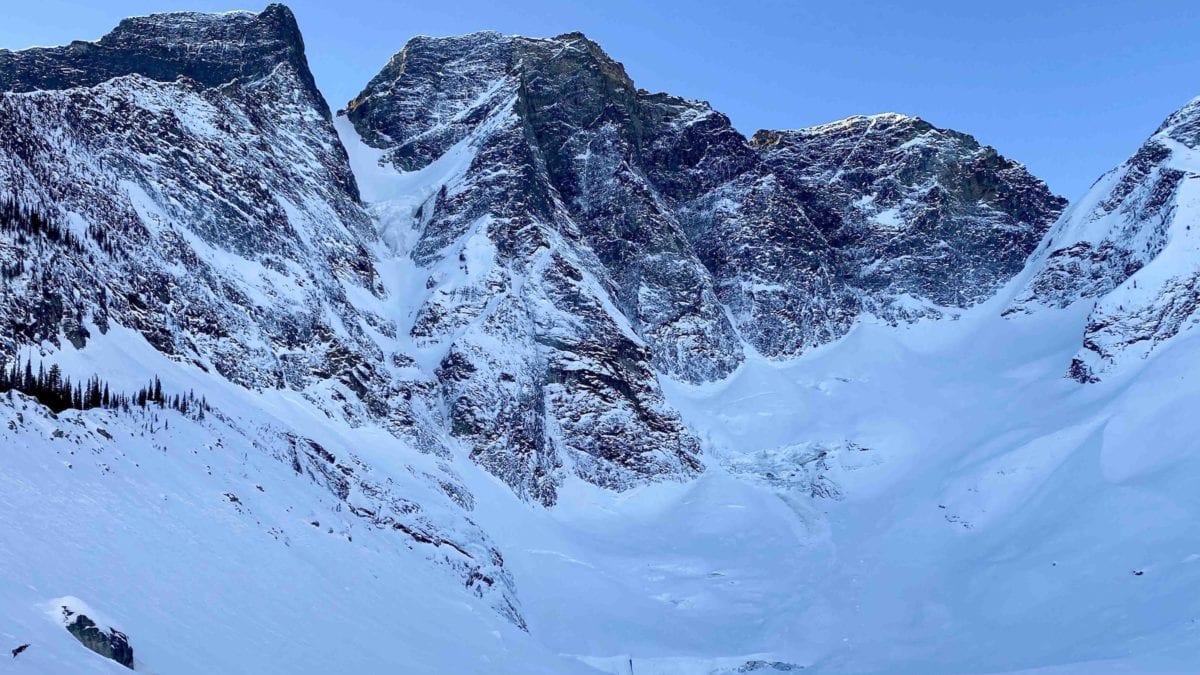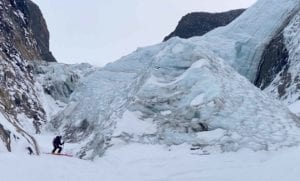Striking Gold in the Monashees: Skiers Bag Serious First Descent
Gold Card Couloir M4+ WI4 C0 60° 800m is a serac-threatened ski line authored by Brette Harrington, Christina Lustenberger and Andrew McNab
 Photo by: © Andrew McNab
Photo by: © Andrew McNab
Brette Harrington balanced in ski boots and crampons six hundred metres up an exposed and icy couloir. With skis strapped in A-frame to her pack, she peered up at a bulging azure serac; the final obstacle blocking a 60 degree snow slope above — and a highly coveted first ski descent. Harrington began climbing the right side of the ice when it elicited a stomach-wrenching boom. Her lightweight axes had awoken the ancient glacial ice and it began to settle underneath her bodyweight. “It made this freaky noise, like [the serac] was about to fall off,” she said. Harrington’s ski partner, Christina “Lusti” Lustenberger, felt the reverberations 20 metres below and knew how perilous their situation could become. The two women were gunning for the first descent of what would become Gold Card Couloir, an often talked about but seldom attempted ski alpinism line in the heart of interior British Columbia.
Harrington bailed off of the ice that day but eyed a rock step on the left that could avoid most of the serac. They began their descent to the valley below, already thinking about another attempt. Two days later, on January 23, Harrington and Lustenberger returned to the col between the north faces of Mount Burnham and Mount Grady in the Monashee Mountains’ Gold Range. Andrew McNab, a local ski guide and regular partner, joined the duo for his second attempt on the line. With low avalanche hazard across the range and little new snow to sluff the skiers off the no-fall zone, the group was eager to take another crack at it. A 45 minute drive from Revelstoke, 30 kilometre sled ride and two hours of skinning deposited the skiers at the base of the fan; setting them up for a long day of boot packing, mixed climbing and high consequence skiing.
The trio climbed efficiently through the first ice step and snowfield, stopping to rope up at the base of the animated serac. This time, Harrington ascended a tongue of névé at the couloir’s leftmost edge and found more supported glacial ice where she could clip into a tool to rest. Soon, the ice overhung above her on the right side, but smooth, glacier polished rock allowed for delicate mixed stemming. Near the end of the pitch the ice began to boom again and Harrington stopped swinging. A fracture line shot out of the ice to her right and she waited several moments to calm her head. Harrington relied on her years of alpine experience to navigate the intricate climbing in ski boots and aluminum crampons — all while avoiding the precarious ice and the consequences of a mistake. “The grade we gave does not really convey the experience of that pitch,” Harrington said. “There were a lot of components that made it feel more intense than just M4.”
Harrington built a rock belay and her partners ascended their sole half rope to avoid swinging into the impulsive ice. With the crux behind them, they motored up the final 200m to the top of the couloir and prepared to drop into one of the gnarliest lines of the season. The no-fall ethos was understood. Any mistake on the 60 degree slope would entail a vicious tumble on hard pressed snow and a spectacular flight over the serac, culminating in hundreds of meters of rag-dolling to the alpine lake far below. Lustenberger and McNab have been extreme ski partners for years, while Harrington said she still felt like a newcomer to this scene. “I’m not a pro skier… I was kind of gripped at the top of the face,” she said. Concerned as she may have been, the skiing, thankfully, was in ideal conditions. “It was the perfect snow for that line,” Lustenberger said. Previous avalanche activity had cleared the couloir of powder snow, leaving a firm and predictable base that would not sweep them over the serac below. Lustenberger led the descent with conservative jump turns until reaching their rock anchor, making three rappels before regaining the 50 degree slope below. Good snow and a final rappel provided passage for the first descent of this impressive 800m line.
While Gold Card is an oft talked about objective — one of the most popular traverses in the Gold Range skirts below it — several factors have staved off suitors until now. Since McNab first laid eyes on the line 13 years ago, he had skied in several times for a look but conditions had only permitted one “real” attempt. He was most often turned around by burly glacial ice climbing or thinly covered snow bridges. Since his initial forays he has already noticed glacial recession of about two metres, a factor he believes contributes to the overhanging ice Harrington was compelled to climb. Part of his success this time around was the prudence to wait for ideal snow conditions and joining a well-rounded team with distinct specialities. He and Lustenberger led the technical descent while Harrington’s deep climbing resume allowed the party to move quickly through the dangerous ice. Despite its label as a ski descent, Harrington believes Gold Card will only succumb to those with proficiencies in alpinism and mixed climbing. “It’s a lot different than hiking to the top of a steep couloir and just skiing it,” she said. Indeed, their grade of 800m, M4+, WI4, C0, 60 degree skiing betrays the true seriousness of this endeavour.



